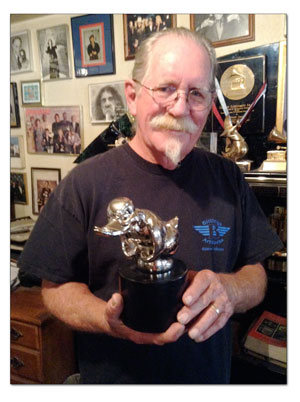
He’s your grammy
I’d had no plans other than killing some time until a local thrift store opened. What could be better than a walk across the public square in the morning sun, maybe a wander through the neighborhood, checking out some of the town’s old houses. On my way through the park I waved toward a city employee who’d just finished dumping a load of clippings from the back of his rather spiffy riding lawnmower. He abruptly dismounted and walked toward me.
 He said, “My name’s Danny. Where are you from?”
He said, “My name’s Danny. Where are you from?”
“From a little town just north of Cortez. And I covet your lawnmower.”
He laughed, perhaps mistaking my envy for a joke. We exchanged a few pleasantries. As it turned out, Danny worked as the city park’s supervisor and knew the town well. He pointed toward an old building two blocks away where he assured me I’d see something special: the place where the trophies for the Grammy Awards were manufactured.
“Here in Ridgway, Colorado?”
“That’s right. Tell them Danny sent you.”
I did, and of course I’m still thanking him for his directions, though when I climbed down the stairs into the artist’s studio and its owner got up from his desk where no doubt he had a few more important things to do than greet strangers who materialized like aliens out of the sunlight, I suspected I should just excuse myself and scurry back into the street. Instead, I blurted the magic phrase, “Danny sent me.”
“Oh yeah, Danny, he often does that.”
We reached to shake hands and made our introductions. As my eyes adjusted to the light, I glanced around and saw a man cave that rivaled all man caves. It was a workshop, a foundry, a painting studio, an office and a museum. Out of this subterranean subconscious John Billings has been expressing his artistic vision for over 40 years.
He’s the man who designs and annually produces The Grammy, an iconic American music award, one that musicians still covet after more than 50 years.
It wasn’t difficult to spot the tiny gramophone-shaped trophies: the 24 karat gold-plating radiated from a shelf where a few special ones were lined up. John does more than simply (and if you watch his YouTube video “The Grammy Man” you’ll see it isn’t simple) fabricate and assemble the awards. He also repairs old Grammys that are sent to his shop by musicians who’d done something as silly as, say, try to crank the miniature record player’s handle that at one time was only cosmetically soldered onto the side of the trophy. Of course, John had eliminated this temptation from the design years ago, but you know how it goes: music aficionados have to play with something.
He told me a story about one of Tony Bennett’s early Grammys that showed up in his studio for repair. As he examined the relic, he realized the gold-plated horn on the tiny gramophone was broken beyond salvation, but he’d received explicit instructions to “repair, not replace!” He looked closely and could see why: an engraved signature graced the inside bevel of the horn. Rather than believing the repair job impossible, John found a replacement horn that matched the older model, located a book so as to teach himself engraving, and he forged the little signature into its very special place. To this day, he said, he hasn’t received any complaints.
I assumed he produced a few dozen trophies annually, but the number of categories since 1959 has increased exponentially, so much so that in 2012 The Recording Academy announced a drastic cut, reducing 109 awards to a more reasonable 78. Still, John Billings crafts as many as 600 trophies for any particular year because “everybody” associated with a winning production wants his or her own little Grammy.
As we circled back toward his desk and I took my final survey of the artist’s cave, I hoped the future might be bountiful for this subterranean niche in Ridgway, and I was pleased the Grammys weren’t being produced in Hollywood. I picked up one of his gems and let the lights glitter off its gold.
“I hope you negotiated a lifetime contract to produce these.”
“Actually, I’m only under contract for three more years.”
“Three years?”
“The Chinese are bidding, and they could win the contract.”
“They want the business?”
“Not likely, but the bean counters are persistent.”
Lifting a nickel-plated figure off a shelf, he told me the duck was currently his “bestselling item.”
Also known as “The Angry Duck” it appeared in two movies, first in Sam Peckinpah’s 1970s film, “Convoy,” and then more recently, in the 2004 Quentin Tarantino movie “Death Proof.” It’s a hood ornament, an icon of a Disney-esque duck pumped up with a fowl attitude.
I thanked my host for his time and snapped a photo before heading out the door. It should be titled “John Billings, made in America.”
May the bean counters be forced to memorize and sing all of Tony Bennett’s songs in Chinese.
– David Feela
